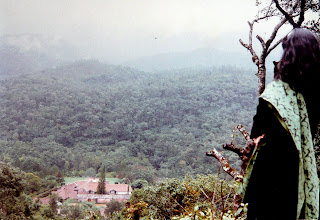Report from the Illustrated London News of AD 1854.Opening of a New Bridge at Travancore - The Maharajah's State Procession-


It is to be admitted that the availability of historical documents, pictures, photographs and other tools for better understanding of our past is rather limited when we consider the history of Travancore and Cochin. Notwithstanding the sincere attempts made by a few of our historians, and other enthusiasts, the desired level of documentations is still elusive.
In this context, I thought it appropriate to bring the following sheets of history for the information of those interested.
The enclosed photo shows the engraving from an original print of over 150 years old, taken from The Illustrated London News Vol XXV of 5th August 1854 titled “Opening of a New Bridge at Travancore - The Rajah's State Procession.”
Full text of the reporting could be seen from the second photograph taken from the print.
In this context, I thought it appropriate to bring the following sheets of history for the information of those interested.
The enclosed photo shows the engraving from an original print of over 150 years old, taken from The Illustrated London News Vol XXV of 5th August 1854 titled “Opening of a New Bridge at Travancore - The Rajah's State Procession.”
Full text of the reporting could be seen from the second photograph taken from the print.
This shows the opening of the new bridge over the Karamana river in Trivandrum by the then Maharajah, Uthram Thirunal Marthanda Varma who reigned between AD 1846 and 1860. He had succeeded his illustrious brother Maharajah Swathi Thirunal.
.jpg)
HH the Maharajah, Uthram Thirunal Marthanda Varma
Two Diwans viz. Krishna Row and later Madhava Row ably assisted the Maharajah in his progressive measures, which included, among others, an attempt on the first census of Travancore.
In AD 1855, the Maharajah issued a proclamation abolishing the monopoly of pepper, and made it a dutiable item like other staples of the country.
Under his rule, Diwan Madhava Row placed the whole administration of Travancore in four divisions viz. Padmanabhapurarn, Trivandrum, Quilon and Cherthalai.
The work of building the stone bridge, pictured alongside, across the Karamana River was completed, by the engineering department under the command of Lieutenant William Henry Horsley, who had been appointed by HH Swathi Thirunal. Reportedly, the bridge cost the exchequer Rupees One hundred thousand only at that time.
The work of building the stone bridge, pictured alongside, across the Karamana River was completed, by the engineering department under the command of Lieutenant William Henry Horsley, who had been appointed by HH Swathi Thirunal. Reportedly, the bridge cost the exchequer Rupees One hundred thousand only at that time.
Lt General William Cullen
Lt General William Cullen was the British Resident of Travancore, (AD 1840-60) during the period and was present on the occasion of opening the bridge by the Maharajah on 17th December 1853.
It is very interesting, informative and even amusing to read the report of the Illustrated London News. See the following:
*“This country is favourably known in Europe by the liberal encouragement given by its Rajah to the cultivation of the arts and sciences. The skilfulness of the native carvers is also appreciated in this Country. A splendid example of their work will be remembered in the magnificent ivory throne presented to the Queen by the Rajah of Travancore, and which attracted so much notice at the Great Exhibition of 1851.”
*“Our View shows, near the centre of the bridge, the Rajah’s magnificent state car, before which the old regal carriages at Versailles, and the most brilliant of our Lord Mayor’s, would have to lower their diminished heads.”
It is very interesting, informative and even amusing to read the report of the Illustrated London News. See the following:
*“This country is favourably known in Europe by the liberal encouragement given by its Rajah to the cultivation of the arts and sciences. The skilfulness of the native carvers is also appreciated in this Country. A splendid example of their work will be remembered in the magnificent ivory throne presented to the Queen by the Rajah of Travancore, and which attracted so much notice at the Great Exhibition of 1851.”
*“Our View shows, near the centre of the bridge, the Rajah’s magnificent state car, before which the old regal carriages at Versailles, and the most brilliant of our Lord Mayor’s, would have to lower their diminished heads.”
*“The car was followed by the Princes, courtiers and native officials in carriages and palanquins, with their attendant host of peons and by a number of elephants in their court costumes”.
*“Only part of the Body Guard is seen in our view; the rest of the procession is lost in the grove of the cocoa-nut trees, and behind the pavilion, where Lt.General Cullen, the British Resident, and other Europeans, shared in the ceremony, and waited on His Highness the Rajah.”
*“The former (Maharajah) is well versed in European science, and is himself an excellent practical chemist. His zeal for the promotion of science has been emphatically exhibited by the liberal scale on which he has for many years maintained a complete Astronomical and Magnetical observatory; and we understand that a second station for the study of Magnetical and meteorological phenomena is now in course of erection on the highest peaks of the Ghats in Travancore. The latter (Lt General Cullen) during his long residence in India, has bestowed his spare time in scientific observation of all kinds , including useful barometrical leveling, of the greater part of India. His encouragement to all scientific works in Travancore, we believe, has been of the greatest moment.”
A good account of the day's proceedings could be read from the book "History of Travancore" by P Sangoonny Menon.
Dubai , 14th March 2008.




Comments
I am grateful to you for sending me the email from CRR.